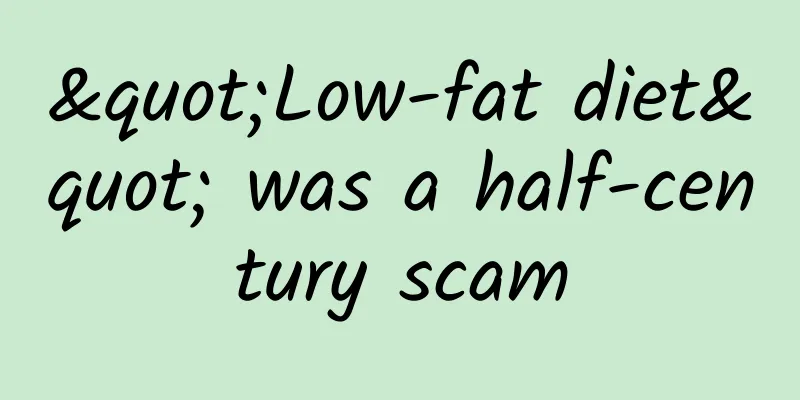"Low-fat diet" was a half-century scam

|
It's the season for losing weight again. When you see those sizzling, oily lamb skewers on the roadside, will you swallow your saliva and walk away quietly? In recent decades, under the propaganda of various media, people generally believe that "eating too much fat is harmful to health", and low-fat diets are widely popular. However, according to the "Chinese Dietary Guidelines (2022)", it is recommended that adults should consume 20% to 30% of their total energy from fat per day, which is not too low. What is going on? Looking back on the story of the "rise of the low-fat diet", it is like a carefully written detective suspense mystery drama. Every step is closely linked and fascinating, especially its beginning, which turned out to be a scam that spanned more than half a century! Copyright images in the gallery. Reprinting and using them may lead to copyright disputes. The beginning of "Fat is guilty" It turned out that "a hypothesis became the truth" 1 The beginning of the "low-fat diet" craze It's actually a hypothesis In the United States, people's fear of dietary fat can be traced back to the 1920s, when people pursued a slim figure and insurance companies would determine basic insurance premiums based on a person's height and weight. Since fat contains more than twice the calories of the same weight of carbohydrates or proteins, people naturally first suspect that dietary fat is the culprit for making people fat. However, this is just an assumption . You should know that the fat you eat and the fat your body grows are two completely different things. The person who helped make the hypothesis true was Ancel Keys, a professor of biology and physiology at the University of Minnesota. Source: Wikipedia In the early 1950s, when Americans were increasingly concerned about the high incidence of heart disease, Keith and his wife began traveling around the world to assess the fat content in the local people's diets and measure their cholesterol levels. At that time, people generally believed that cholesterol was a major factor in causing heart disease. In this process, Keith gradually came to some "conclusions": "So far, only the fat factor seems to be the most important." Coronary heart disease cannot be simply attributed to genetics, but must be caused by diet . However, Keith did not follow the correct research method to summarize and generalize during his travels and studies. He only observed a small number of people and did not use scientific methods to measure the content of various substances in their diets, but he confidently showed that the total amount of fat was the main factor leading to heart disease. In the mid-1950s, Keys began to classify dietary fats. After a small, short-term experiment on schizophrenia, he found that the subjects' blood cholesterol increased after consuming saturated fat, while cholesterol decreased when consuming vegetable oils. He then published a series of papers in top medical journals, confidently claiming that reducing saturated fat intake can lower serum cholesterol. Now it seems that this is another mistake. However, his seemingly logical reasoning that catered to the needs of the public quickly gained popularity throughout society. Keys himself also gained the top position in the American nutrition community and appeared on the cover of TIME magazine on January 13, 1961. Keys taught people to significantly reduce dietary fat, especially natural fat from animal sources, and eat vegetable oil instead. On September 23, 1955, then-President Dwight David Eisenhower suffered a heart attack. The next day, Paul White, the president's personal physician, a good friend and believer of Keith, held a press conference and issued an appeal to the American people with the authority of the president's personal physician: quit smoking, reduce stress, and eat less saturated fat and cholesterol . Over the next few months, White continued to inform the nation about the president's health. As The New York Times promoted Keys' "low-fat diet" theory, it became a household name. Keys used that influence to join the nutrition committee of the American Heart Association (AHA), which in 1961 issued a report advising people at high risk of heart disease to reduce their intake of saturated fat, recommending "reduced or controlled fat intake under medical guidance, with judicious substitution of polyunsaturated fats for saturated fats as a possible means of preventing atherosclerosis and reducing the risk of heart attack and stroke." 2 The "Seven Countries Study" with academic fraud caused a sensation The US government is starting to teach people to eat less fat In 1970, Keys published his more famous "Seven Countries Study" at the American Heart Association. As of 2004, the "Seven Countries Study" had been cited nearly 1 million times in various medical literature. However, the data from the "Seven Countries Study" was carefully selected by him to support his fat hypothesis, while the data from the other 15 countries were selectively ignored by him because they did not fit his argument. Obviously, this is an act of academic fraud. In addition, there are two major problems with the "Seven Countries Study". First of all, this is a correlation study, which cannot prove causality . Correlation and causality are two concepts that are easily misunderstood. Professor Wang Liming of Zhejiang University once made a very vivid analogy. If you conduct a large-scale survey on clothing and diseases, you may find that "white-collar workers" who wear suits to work every day are more likely to suffer from heart disease than "blue-collar workers" who wear round-necked shirts to work. However, if you conclude that "wearing suits is prone to heart disease", you are wrong. Secondly, "simplifying complex issues" divides food into three major nutrients: carbohydrates (sugars), protein, and fat; and further subdivides fat into saturated fat, unsaturated fat, and trans fat. This method ignores the complexity of food and biology. However, despite the huge methodological loopholes and the subjectivity of data selection in the hypothesis that "fat makes people sick and saturated fat causes cardiovascular disease", all these problems were ignored. The "Seven Countries Study" even caused a sensation and affected the government's decision-making. In 1977, the United States published the first edition of the Dietary Goals for Americans (changed to the Dietary Guidelines for Americans after 1980), teaching American citizens to reduce fat intake, increase the grain content in the diet, and replace most animal fats with industrially processed vegetable oils. From then on, the "low-fat diet" entered thousands of American households. Fat was convicted, and a hypothesis became truth. Sweet and deadly However, the popularity of the "low-fat diet" has led to two consequences. First, people consume a lot of vegetable oil to replace animal fat . Due to the needs of taste, preservation, processing technology, etc., oil production companies hydrogenate liquid vegetable oil rich in polyunsaturated fatty acids to make it solid. Hydrogenated vegetable oil is popular, but the hydrogenation reaction brings trans fatty acids to vegetable oil. Second, carbohydrates (sugar) have replaced fat as the main source of energy in food . The second consequence may be even more harmful. In fact, sugar and trans fatty acids are the real culprits that have led to a surge in obesity and cardiovascular disease. 1 Trans fatty acids? Industrial waste! Keys's views were deeply rooted in the hearts of the people through the promotion of the government and media propaganda. Saturated fat was declared guilty, and hydrogenated vegetable oil replaced saturated fat and was widely used since the 1960s. In the late 1980s, hydrogenated vegetable oil became the mainstay of the food industry. Potato chips, biscuits, cakes, cookies, shortening, margarine, fried foods in fast food restaurants, baked foods, etc. all relied on it. Foods baked and fried with hydrogenated vegetable oil as shortening tasted better and had a more delicate texture than the oils used before. Since saturated fat was generally believed to cause obesity and heart disease at the time, trans fatty acids, which came from vegetable oil, were labeled as good for health by manufacturers . Copyright images in the gallery. Reprinting and using them may lead to copyright disputes. Trans fatty acids can cause harm to the human body in several ways: ① Enter the cell membrane, destroy the normal cell membrane structure, and impair cell function; ② One of the main inducing factors of inflammation, hindering the function of ω3- fatty acids; ③ Increase triglycerides and low-density lipoprotein cholesterol (bad cholesterol) in the blood, reduce high-density lipoprotein cholesterol (good cholesterol), and induce cardiovascular disease; ④Causes insulin resistance, easily leading to obesity and diabetes; ⑤There is a clear correlation with cancer; ⑥Closely related to Alzheimer's disease. 2 Carbohydrates, the hidden killer Another consequence of the “low-fat diet” is that people use carbohydrates instead of fat as the main source of energy. Today, people have a clear understanding of the functions of sugars and their relationship with health. The main function of sugars in the human body is to provide energy and other special functions. However, consuming a large amount of sugars will bring many adverse effects to health. Scientific research has found the correlation between sugars and many diseases such as obesity, diabetes, and cancer. Finding the truth, step by step Saturated fats in the diet, especially animal fats, naturally contain more calories and have a similar chemical structure to body fat. When Keys began looking for the culprit of heart disease in 1951, he first pointed the finger at saturated fats. We have repeatedly emphasized that this is just a hypothesis, and then this hypothesis, after an inaccurate and biased argument, became a truth and was openly included in the Americans' Dietary Guidelines. In the more than half a century since Keys proposed the "low-fat diet" hypothesis in the 1950s, doubts and challenges to this hypothesis have never stopped. However, these voices have been drowned in the mainstream of the "low-fat diet". What is commendable is that humans have never stopped pursuing the truth and related experiments have been ongoing. Although the Dietary Guidelines advocating a "low-fat diet" have been issued and the American people have consciously followed them, the obesity incidence among Americans has skyrocketed over the past half century, and the incidence of diabetes and heart disease has increased instead of decreased. Early skeptical voices were suppressed or selectively ignored, but most "low-fat diet" experiments failed miserably, forcing people to re-examine. More and more scientists began to question, and the endless stream of research results denied the connection between fat and obesity and cardiovascular disease. The real culprits of modern diseases such as obesity, cardiovascular disease, and diabetes have finally been found: sugar and trans fatty acids. In 2003, the World Health Organization recommended that the energy supply ratio of trans fatty acids in the diet should be less than 1%. On November 7, 2013, the U.S. Food and Drug Administration removed the main source of trans fatty acids (partially hydrogenated vegetable oils) from the "Generally Recognized as Safe" (GRAS) list. So far, people have begun to re-recognize the importance of fat on the table and gradually accepted the fact that "fat does not cause obesity and cardiovascular disease, the real culprits are sugar and trans fatty acids." Saturated fat is not that scary. But I don't recommend you to eat more The end of the story seems to prove that saturated fat is harmless, but does this mean we can eat it without restraint and enjoy it to our heart's content? Of course not! Currently, whether it is China's dietary guidelines, the United States' dietary guidelines, or the World Health Organization, the American Heart Association and other cardiovascular-related guidelines and expert consensus all recommend: limiting daily saturated fatty acid intake . According to the "Chinese Residents' Dietary Guidelines (2022)", the total fat energy supply ratio is 20% to 30%. Intake of more than 30% may cause many health problems! Regarding saturated fat, the Chinese Dietary Guidelines recommend that the total amount of saturated fat consumed by each adult every day should be less than 10% of the total dietary energy. Among them, the daily calorie requirement for an average lightly active adult female in China is about 1700 kcal, and for a male it is 2150 kcal, which means that the daily saturated fat intake of an adult should be controlled between 18 and 23 grams . The Biography of Fat China Science and Technology Press author Wang Ying, Bachelor of Arts from Peking University, PhD from University of Illinois, Postdoctoral Fellow at Stanford University Today, we have entered an era of collective "fat hatred", where everyone is afraid of it and avoids it. This rejection of fat has led to society's pursuit of thinness. In order to reduce fat, people spend a lot of time and energy, completely forgetting the most authentic meaning of fat to humans - giving and maintaining life. This is a popular science book about fat, based on topics such as humanities history, biochemistry, physiology, plastic surgery, stem cells and gene editing. It uses detailed information, vivid stories and humorous language to introduce the chemical composition, cell structure, biological principles, genetic mechanism and cultural aesthetics of ancient and modern times at home and abroad, revealing the scientific principles of obesity and the underlying logic of weight loss, covering everything. After reading this book, you can understand the mechanism of obesity without any basic knowledge and learn how to lose weight scientifically and effectively. At the same time, the book also introduces the application of fat in plastic surgery and the international frontier progress of fat research, pointing out the direction for readers who are suffering from obesity. I hope you can understand the true nature of fat from this book, recognize the value of fat, no longer have excessive fear and hatred of fat, and look at fat scientifically. Planning and production Source: Book "The Biography of Fat", Science and Technology Press of China Author: Wang Ying, Bachelor of Peking University, PhD of University of Illinois, Postdoctoral Fellow of Stanford University Review丨Zhang Yu, Researcher, Chinese Center for Disease Control and Prevention, Doctor of Medicine Planning丨Yinuo Editor: Yinuo, Linlin Proofread by Xu Lai The cover image and the images in this article are from the copyright library Reprinting may lead to copyright disputes |
<<: In the screen age, how to minimize the impact of electronic screens on children?
>>: What kind of “core” is installed in such a “bad-tempered” electric bicycle?
Recommend
Marketing analysis: Weibo followers increased by 700,000, the gold mine behind the popularity of Jiangxi Huanong Brothers’ bamboo rats!
% ignore_pre_1 % When I noticed this account, they...
Will the coronavirus Delta and Omicron merge into a more ferocious "new poison king"?
While the Omicron variant is worrying people, two...
The most powerful Zhihu promotion and drainage method in 2019
A few days ago, my famous Zhihu account in the sk...
What can domestic new energy vehicles rely on to take a bite of the huge cheese of the European market?
For quite a long time, domestic automobile manufa...
What is sleep paralysis? People who are often "pressed" should be careful!
Ms. Li, 24 years old, often works overtime and st...
A chart to understand the gender ratio of Silicon Valley technology companies
Until recently, gender and racial diversity data ...
NetQin hit again: PwC employee leaks secrets on Weibo
Recently, after NetQin was shorted by Muddy Water...
Will humans be replaced by artificial intelligence? Machines cannot do this
Copyrighted images from the gallery, unauthorized...
SEM delivery: From entry to mastery in just 5 steps!
SEM delivery is quite simple in the early stages....
Who is the artificial intelligence company that accurately predicted that Leo would win an Oscar?
On March 1, Leo finally won the Best Actor award ...
Vivo is not installing anymore! The sales king has launched PhoneGPT, which can refurbish all the phone calls, text messages and notes! It is worthy of being the model hiding leader in the domestic mobile phone industry!
Editor | Yifeng Produced by | 51CTO Technology St...
GDC 2015: The secrets of Chinese mobile game social operations
Recently, KTplay, as China's largest mobile g...
China Charging Alliance: Operation status of national electric vehicle charging and swapping infrastructure in July 2022
National Electric Vehicle Charging and Replacemen...
Case Analysis | What is JD.com’s “Koi” information flow advertising like?
Today, the editor will share with you a JD.com &q...
The key method of excellent creative advertising!
Those advertisements that seem creative and amazi...









